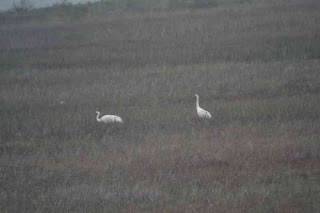 |
| Great-tailed Grackle |
There was an interesting flower in the grassy areas along the dikes, which was a species of paintbrush (Castilleja sp.). Most species we've seen have been brilliant red, or bright yellow. The pink tones of this species was interesting.
 |
| Paintbrush sp. (Castilleja sp.) |
Brazoria was one of two places on the trip where a potential life bird for us could be found; Black Rail. They start calling in February and March, though mostly at night. We had hopes that one might let out a vocalization during the day we were there, but the high winds dampened that optimism, and we didn't hear any rails at Brazoria. Our next stop, San Bernard NWR, was an even better place for Black Rails, but the weather pattern was not changing. One of the highlights here, when the fog lightened up a bit, was a White-tailed Kite. The photo below is the full-frame version as the editing software I have on my new laptop has decided to not allow me to crop photos and export to JPG any more.
 |
| White-tailed Kite |
A numerous species in all these coastal refuges, and indeed even in parts of Louisiana, was Savannah Sparrow. So, I gave up and took a photo of one (again, full-frame here).
 |
| Savannah Sparrow |
We had high hopes for the town of Freeport, but it had suffered quite a bit from Hurricane Ike (as had Brazoria NWR). We drove down the shoreline unable to see the Gulf of Mexico due to the fog and rain, though there were a few shorebirds, and some pelicans (both species) very close to shore. The wind was still very strong, keeping a lot of birds down. Another photo of Great-tailed Grackle was the best at this site, as it sat on a stump and "sang" in loud ringing tones.
 |
| Great-tailed Grackle |
Heading southward, with the fog clearing a bit and no more rain, but with the wind strengthening, we stopped near Port Lavaca to walk a boardwalk into a small patch of coastal salt marsh, with the hopes of seeing or at least hearing a Seaside Sparrow. No luck, but a Snowy Egret begged to have his photo taken.
 |
| Snowy Egret |
And a Long-billed Curlew was feeding in this marsh fairly close.
 |
| Long-billed Curlew |
We stayed the night in Rockport, and on Thursday, March 1, we went straight to the Aransas National Wildlife Refuge. Fog and wind again plagued us, but the fog at least wasn't as bad as the last two days, but the mosquitos were still quite abundant and aggressive. The objective here, of course, was to see Whooping Cranes. There were three off the huge observation tower, which required using the 800mm attachment to allow me to use my SLR with my spotting scope. Even so, the birds aren't big in the frame. We saw a total of 8 there; these are members of the only wild flock, so are the only "countable" ones in North America.
 |
| Whooping Cranes |
 |
| Whooping Cranes |
Showing off, and very tame, was a flock of Wild Turkeys at the visitors center. I didn't need to zoom out to 400mm to take this photo, but 120mm was quite sufficient (and I even had to back up!).
 |
| Wild Turkeys |
After touring the refuge completely we headed south to the town of Lamar. Goose Island State Park is famous for its large live oak tree, but we had gotten a tip that because of drought in the freshwater portions of Aransas, and a Red Tide offshore, some of the Whooping Cranes had spread out. We did indeed find two of them in fields there, coming in to a corn feeder that a homeowner had filled for them. What a great feeder bird! Next we went to the South Jetty at Port Aransas in the hopes of seeing some shorebirds or perhaps a Northern Gannet offshore. The fog was much better, but it was still out there far offshore, preventing any distant scoping. Closer in, Brown Pelicans skimmed back and forth.
 |
| Brown Pelican |
Some had their breeding colors; bright red on the pouch.
 |
| Brown Pelican |
Most interesting here was the two Green Sea Turtles that were just off the jetty, occasionally coming up for air. I really wanted to present crops of the photos here, which show the turtles much better, but the full-frame version below is all that my recalcitrant software will allow for now.
 |
| Green Sea Turtle |
 |
| Green Sea Turtle |
From Aransas Pass we drove south to Kingsville where we spent the night, preparing for the next four days in the Rio Grande Valley, which will be covered in the next posting in a few days.



No comments:
Post a Comment